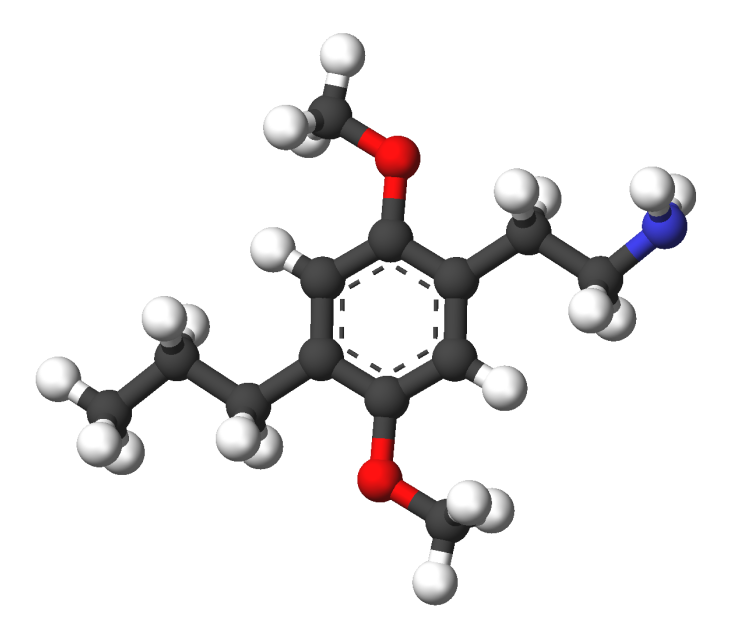Summary
2C-P is a notably potent and long-lasting psychedelic phenethylamine within the 2C family.
| Identifiers | |
|---|---|
| CAS Number | 207740-22-5 |
| 3D model (JSmol) | Interactive image |
| ChEMBL | ChEMBL339136 |
| ChemSpider | 21106226 |
| PubChemCID | 44350080 |
| UNII | DPS1JI878J |
| CompTox Dashboard(EPA) | DTXSID30174849 |

Chemistry
2C-P is scientifically known as 2,5-dimethoxy-4-n-propylphenethylamine or, more elaborately, 2-(2,5-dimethoxy-4-propylphenyl)ethanamine. In its most common form, it appears as a white powder or white crystals, often in the hydrochloride salt form.
Alexander Shulgin’s 2C-P crude freebase, which is soluble in chloroform, initially presented as an off-white coloured oil. After solvent removal through vacuum evaporation, it was distilled at a temperature range of 100–110 °C at 40 Pa (0.3 mmHg). This process transformed the substance into a “water white” colour, and upon cooling, it spontaneously crystallized.
Effects
2C-P induces potent hallucinogenic, psychedelic, and entheogenic effects characterized by vivid open-eye and closed-eye visualizations. When ingested, its onset can be notably slow, with peak effects typically manifesting between 3 to 5 hours. The peak itself extends for a duration of five to ten hours, while the overall experience can encompass up to 20 hours.

Dose
In his book PiHKAL, Shulgin detailed the dosage range for 2C-P, typically falling between 6 to 10 mg. He also noted that while most reports within the 6 to 12 mg range were positive, there was one instance of a single 16 mg dosage resulting in a clear overdose, leading to a challenging physical experience that should not be repeated. Shulgin emphasized the necessity of individual titration when using 2C-P, as there may be limited room for dosage flexibility between what is considered modest or sufficient and what might become excessive. It’s worth mentioning that 2C-P is one of the most potent substances within the 2C family of psychedelics, with its potency rivalling that of 2C-TFM.
Overdoses and deaths
In September 2013, at a concert in Connecticut, USA, several individuals required emergency medical assistance, including CPR and defibrillation, due to the ingestion of unknown or unreported dosages, which led to the hospitalization of seven people. Four of them remained hospitalized for at least one day. Fortunately, none of the overdose victims succumbed to the effects. This incident was described as a “mass casualty event” by the police, who attributed the problems to the consumption of 2C-P and substances purportedly sold as “Molly,” a common street name for MDMA.
Tragically, in September 2017, Louella Fletcher-Michie, the daughter of actor John Michie, lost her life to a 2C-P overdose at the Bestival festival in Dorset, UK. Her case marked the first reported fatality associated with 2C-P. Her boyfriend faced a manslaughter conviction for providing her with the drug and neglecting to assist for over six hours after she overdosed. However, in August 2020, his conviction for failing to act was overturned.
Legal status
2C-P is not subject to scheduling under the United Nations Convention on Psychotropic Substances.
However, its legal status varies in different countries:
Canada: As of October 31, 2016, 2C-P is classified as a controlled substance (Schedule III) in Canada.
China: Since October 2015, 2C-P has been categorized as a controlled substance in China.
Denmark: In Denmark, 2C-P has been included in the list of Schedule B controlled substances.
Germany: 2C-P is classified as an Anlage I controlled drug in Germany.
Sweden: The Riksdag in Sweden added 2C-P to the Narcotic Drugs Punishments Act under Swedish Schedule I, which covers substances, plant materials, and fungi with no established medical use. This decision was made on August 16, 2016, and published by the Medical Products Agency (MPA) in regulation HSLF-FS 2016:80, listing it as 2,5-dimetoxi-4-propylfenetylamin.
United Kingdom: 2C-P is considered a Class A drug in the UK.
United States: 2C-P was placed in Schedule I (DEA Drug Code 7524) in the United States. This designation makes it illegal to possess, distribute, or manufacture without a proper license. This legal change occurred through the Synthetic Drug Abuse Prevention Act of 2012 (SDAPA), which was signed into law by then-US President Barack Obama on July 9, 2012. It came into effect on January 4, 2013.
FAQ
- What is 2C-P?
- 2C-P is a psychedelic phenethylamine compound that belongs to the 2C family. It is known for its hallucinogenic and psychedelic effects.
- How is 2C-P typically used?
- 2C-P is usually ingested orally, with effects beginning to manifest after a slow onset. It is consumed for its psychedelic properties and ability to induce altered states of consciousness.
- What are the effects of 2C-P?
- The effects of 2C-P include hallucinations, altered perceptions, and changes in sensory experiences. It can lead to intense and long-lasting psychedelic experiences, with the peak effects lasting up to 20 hours.
- What is the recommended dosage for 2C-P?
- The recommended dosage can vary, but according to Alexander Shulgin’s book PiHKAL, the typical range is 6 to 10 mg. It’s important to note that individual responses may differ, and caution is advised when determining the appropriate dosage.
- Is 2C-P legal?
- The legal status of 2C-P varies by country. In some places, it is classified as a controlled substance and is illegal to possess, distribute, or manufacture without the appropriate authorization. It’s crucial to be aware of the specific laws in your region.
- What are the risks associated with 2C-P use?
- As with any psychedelic substance, there are potential risks, including adverse reactions, unpredictable effects, and the possibility of overdose. It is essential to use caution, be informed, and consider harm-reduction practices when using 2C-P or any similar substances.
- Can 2C-P be used for therapeutic purposes?
- While some individuals have explored the therapeutic potential of psychedelics, the use of 2C-P for therapeutic purposes is not well-documented, and it is not considered a standard treatment option.
- Is 2C-P related to other substances in the 2C family?
- Yes, 2C-P is part of the 2C family of phenethylamines, which includes various compounds known for their psychedelic effects. These substances share structural similarities and some pharmacological properties.
- How should I approach using 2C-P safely?
- Prioritize safety by researching the substance, understanding the legal status in your region, starting with a low dose, and using harm reduction strategies. It is also advisable to have a trusted and sober individual present during your experience.
- Where can I find more information about 2C-P?
- You can access more information about 2C-P through reliable sources, books, and online resources dedicated to psychedelic compounds. Additionally, consulting with healthcare professionals or harm reduction organizations can provide valuable insights and guidance.
References
- “Explore Erowid’s 2C-P Vault: Visuals.” Erowid.org. Archived from the original on 2015-04-12. Retrieved 2015-04-06.
- “Discover Erowid’s Online Books: “PIHKAL” – Entry #36 on 2C-P.” Erowid.org. Archived from the original on 2015-04-21. Retrieved 2015-04-06.
- “Four Hospitalized Due to Overdose at Quassy Amusement Park Concert – WTNH.com Connecticut.” 27 November 2013. Archived from the original on 27 November 2013.
- “Molly’s Potent and Lethal Cousin: The New ‘It’ Drug.” HLN TV. Archived from the original on 2016-03-05. Retrieved 2015-04-06.
- “Police Report: ‘2C-P’ and ‘Molly’ Linked to Drug Overdoses at Amusement Park Concert.” CNN.com. Archived from the original on 2016-03-04. Retrieved 2015-04-06.
- Siddique, Haroon (5 February 2019). “Court Hears Party Drugs Contributed to the Death of TV Actor’s Daughter at Music Festival.” The Guardian. Archived from the original on 5 February 2019. Retrieved 5 February 2019.
- “Bestival Tragedy: Ceon Broughton Sentenced for Manslaughter.” BBC News. March 1, 2019. Archived from the original on September 14, 2019. Retrieved September 3, 2019.
- “Regulations Amending the Food and Drug Regulations (Part J — 2C-phenethylamines).” The Government of Canada. April 15, 2016. Archived from the original on 2016-08-31. Retrieved 2017-06-22.
- “关于印发《非药用类麻醉药品和精神药品列管办法》的通知” (in Chinese). China Food and Drug Administration. 27 September 2015. Archived from the original on 1 October 2015. Retrieved 1 October 2015.
- “Read the Announcement on Controlled Euphoric Substances in Danish Law.” Retsinformation.dk. Archived from the original on 2013-10-04. Retrieved 2013-09-13.
- “Download the Governmental Collection of Health and Social Service Regulations (PDF).” (PDF) Archived from the original on 2017-10-30. Retrieved 2017-04-21.
- “Bestival Tragedy: Ceon Broughton Sentenced for Manslaughter.” BBC News. BBC. 1 March 2019. Archived from the original on 1 March 2019. Retrieved 1 March 2019.
- “Read the Text of S. 3190 (112th): Synthetic Drug Abuse Prevention Act of 2012 (Introduced Version) on GovTrack.us.” GovTrack.us. Archived from the original on 2015-04-12. Retrieved 2015-04-06.
- “Explore the Rules – 2013: Establishment of Drug Codes for 26 Substances.” Archived from the original on 2015-03-22. Retrieved 2015-04-06.